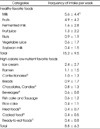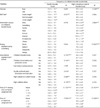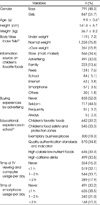Abstract
Objectives
Methods
Results
Conclusions
Figures and Tables
Table 2
Frequency of children's favorite foods intake

1) Mean ± S.D. (converted to intake frequency per week, 0=not at all, 0.5=1~3 times a month, 2=1~3 times a week, 5=4~6 times a week, 7=once a day, 14=more than twice a day)
2) Cookie, biscuit (sweet snacks), potato chips etc. (salty snacks), cereal, cereal bar
3) Chocolate, chocolate bar, candy, jelly
4) Processed milk, carbonated drink, high-caffeinated drink, fruit flavor drink, others drink (ionic drink, vitamin drink etc.)
5) Fried chicken·chicken gangjeong, others fried (Fried squid etc.)
6) Skewers, Dumplings, dukbokki, hamburger, pizza
7) Gimbaps, sandwiches
Table 3
Comparison of children's favorite foods intake and social demographic variables

1) Mean ± S.D.; frequency of children's favorite foods intake per week
2) BMI (body mass index) percentile based on 2007 Korean national growth charts for children and adolescents (underweight: BMI percentile < 5; normal weight: 5 ≤ BMI percentile < 85; overweight: 85≤ BMI percentile)
3) *: p<0.05, **: p<0.01, **: p<0.001 by t-test
4) *: p<0.05, **: p<0.01, **: p<0.001 by ANOVA
abc: Values with the different small letter superscript are significantly different among column by Duncan's multiple range test at p<0.05.
Table 4
Comparison of policy cognition, educational experience among clusters

1) Frequency of children's healthy favorite foods intake in clusters: low intake −7.3 ± 3.4 times per week, medium intake-18.1 ± 3.6 times per week, high intake-32.7 ± 6.2 times per week
2) Policy cognition consisted of policy perception, policy usefulness, policy necessity and buying intention; total score-23 points
3) Mean ± S.D. (policy perception: 10 points, policy usefulness: 4 points, policy necessity: 6 points, buying intention: 3 points, educational experience: 3 points)
**: p<0.01, **: p<0.001 by ANOVA
abc: Values with the different small letter superscript are significantly different among row by Duncan's multiple range test at p<0.05.
Table 5
Comparison of policy cognition, educational experience among clusters

1) Frequency of children's high-calorie low-nutrient favorite foods intake in clusters:low intake −4.3 ± 2.2 times per week, medium intake-11.5 ± 2.4 times per week, high intake-22.7 ± 5.0 times per week
2) Policy cognition consisted of policy perception, policy usefulness, policy necessity and buying intention; total score-23 points
3) Mean ± S.D. (policy perception: 10 points, policy usefulness: 4 points, policy necessity: 6 points, buying intention: 3 points, educational experience: 3 points)
*: p<0.05 by ANOVA




 PDF
PDF ePub
ePub Citation
Citation Print
Print





 XML Download
XML Download